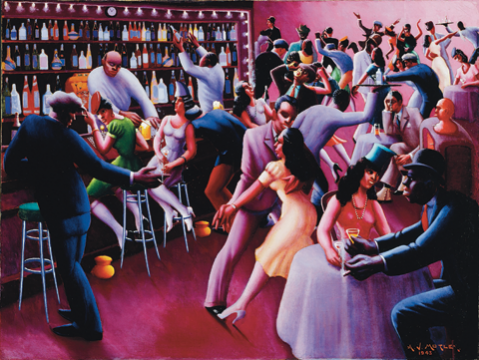
Migration, Immigration, and Art
Last Saturday I spent the day at the Art Institute and stumbled upon an amazing exhibit on the lower level of the Modern Wing called They Seek a City: Chicago and the Art of Migration. This show explores artists immigrating from Europe and African American artists migrating from the south during a period called the Great Migration.
I was immediately drawn to the works of African American artists in Chicago during the Great Migration because, to put it quite plainly, I’m an African American and an artist, and my family migrated to Chicago from New Orleans in the mid 1920s. My great grandfather, Andrew, first came up in search of a job, and my great grandmother, Anita, along with my grandmother and great uncle followed shortly after. They moved into the Bronzeville neighborhood, and were it not for them, I wouldn’t be a Chicagoan.
As an educator, I naturally starting thinking of ways to share this exhibit with students in a meaningful way. There are so many educational connections that can be made with an exhibit like this. Working in an urban education system like CPS, I know there are many students who have a story similar to mine who have either migrated north or immigrated from another country and who’ve maybe never asked their family about it. What a great opportunity for a student to get to know more about their personal family history, how their family history ties into the larger picture of U.S. history, and how artists have been telling their story all along.
I remembered for my Art Integration course last year how everyone had to come up with (surprise) an integrated unit using the 4Mat cycle, which engages different types of learners and different brain modalities. The exhibition at the Art Institute right now actually fits the low relief sculpture and U.S. History integrated unit I came up with really well.
In short, my idea was to have students either take a photograph or bring in a small object that belongs to someone at least one generation older than them in their family. They would then interview that person about their family history (i.e. when did we move here, where were we before, why did we move, whose idea was it to leave, etc.) and write up a reflection on their interview. I would then teach a lesson on the role art played in immigration, and they would do several preparation sketches of their object, finally creating a 6×6 cardboard low relief sculpture of their object. Each class would put their low reliefs together to create a larger relief to be displayed in the school where everyone would be represented.
I highly recommend this exhibit if you’re someone who is interested in integration ideas. Let me know if you think of other integration connections you can make with this!
